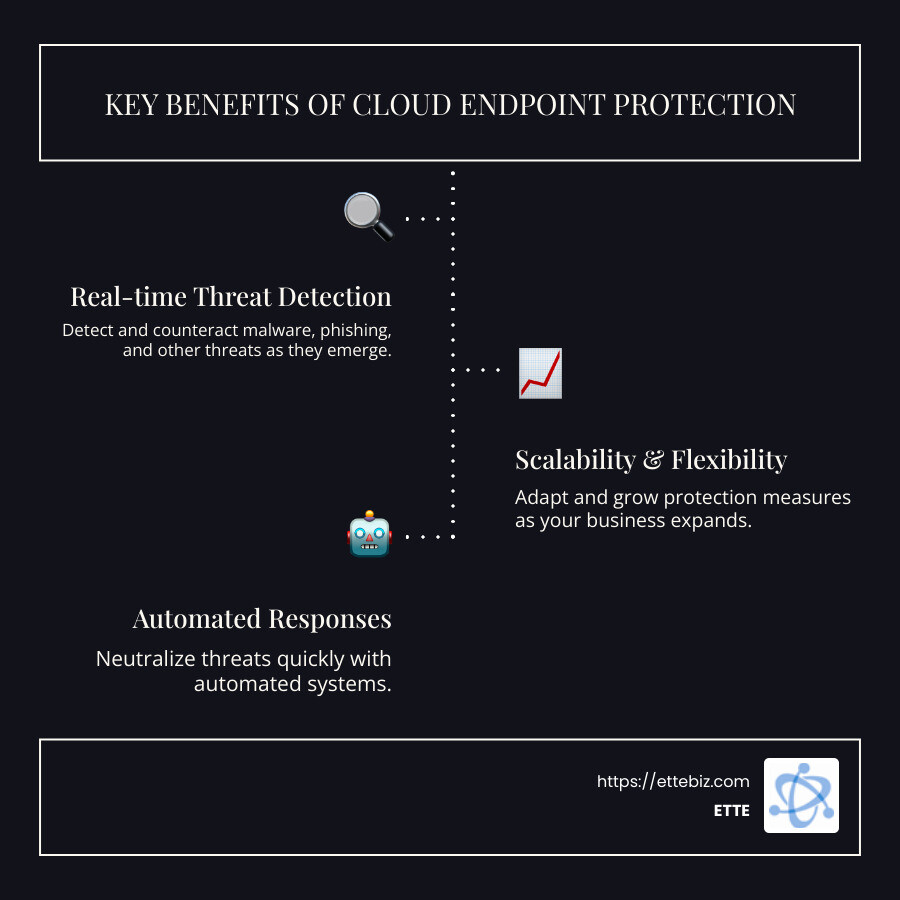Cloud Endpoint Protection: Safeguarding Data in the Cloud
In the age of digital change, cloud based endpoint protection is at the forefront of securing sensitive information. It offers a vital solution for businesses looking to protect their data from cyber threats. Here’s a quick breakdown of its key benefits:
- Real-time threat detection: Protects against malware, phishing, and more.
- Scalability and flexibility: Grows with your business needs.
- Automated responses: Quickly neutralizes threats when detected.
As technology continues to evolve, securing data in the cloud is more crucial than ever. Cloud endpoint protection involves safeguarding devices like computers, laptops, and smartphones that connect to your network. These endpoints are potential gateways for cyber threats that can disrupt operations and compromise sensitive information.
With the rise in remote work and increased usage of cloud applications, endpoint security ensures that users can access the cloud safely from anywhere, without sacrificing data integrity. This not only improves security but also streamlines data governance, maintaining compliance with various data protection standards.
Modern cloud solutions harness machine learning for advanced threat analysis. They observe system behaviors, predict potential risks, and guard against emerging cyber threats, thus offering a robust defense against both known and unknown vulnerabilities.
By adopting cloud endpoint protection, businesses, even small non-profit organizations in regions like Washington, DC, can enjoy a seamless digital change while keeping their data safe.

Common cloud based endpoint protection vocab:
– endpoint security and management
– endpoint security firms
– endpoint security testing
Understanding Cloud-Based Endpoint Protection
As businesses increasingly rely on digital solutions, safeguarding data through cloud-based endpoint protection becomes essential. This form of protection leverages cloud computing to improve security measures, offering several key features that set it apart from traditional solutions.
Key Features of Cloud-Based Endpoint Protection
- Real-Time Threat Detection
Cloud-based endpoint protection excels in real-time threat detection. By continuously monitoring activities and analyzing data from multiple sources, it identifies potential threats almost instantly. This rapid detection is crucial in preventing damage from zero-day exploits and advanced persistent threats (APTs).
- Malware Prevention
Traditional security methods rely heavily on signature-based detection, which can be slow to adapt. In contrast, cloud-based systems use advanced techniques like behavioral analysis to detect and prevent malware. This approach examines the behavior of applications and files, identifying suspicious patterns that may signal a threat.
- Centralized Management
With centralized management, security teams can oversee all endpoints from a single platform. This simplifies policy enforcement and ensures consistent protection across all devices, whether they’re in the office or remote.
Advantages Over Traditional Solutions
- Scalability and Flexibility
One of the standout benefits of cloud-based solutions is their scalability. As your organization grows, these solutions can effortlessly expand to cover new devices without manual intervention. This flexibility is vital for adapting to changing business needs and technological advancements.
- Automated Response
Cloud-based endpoint protection automates responses to detected threats, minimizing the time between detection and action. This automation can significantly reduce the impact of a cyberattack, keeping your systems safe with minimal human intervention.
- Advanced Behavioral Analysis
Unlike traditional methods, which often rely on known threat signatures, cloud-based solutions incorporate behavioral analysis. This technique enables the system to detect anomalies and potential threats by analyzing the behavior of files and applications in real time.
- Improved Threat Detection
By using cloud computing, these solutions can process vast amounts of data quickly and efficiently. This capability allows for more effective detection of sophisticated threats that might evade traditional security measures.
In summary, cloud-based endpoint protection provides robust, scalable, and flexible security that can adapt to the evolving threat landscape. By implementing these advanced solutions, organizations can protect their data more effectively, ensuring secure cloud access for users across all locations.
Implementing Cloud-Based Endpoint Protection
Implementing cloud-based endpoint protection involves several critical steps to ensure your organization’s data remains secure. Here’s how you can effectively deploy this protection and the types of threats it addresses.
Best Practices for Deployment
1. Endpoint Agent Installation
The first step in implementing cloud-based endpoint protection is installing endpoint agents on all devices. These agents collect data on file activities, network connections, and user behaviors, sending this information to the cloud for analysis. Proper installation and configuration are crucial for accurate data collection and threat detection.
2. Cloud Analytics Utilization
Leverage cloud analytics to process and analyze the data collected by endpoint agents. With advanced machine learning models, cloud analytics can identify unusual patterns or potential threats in real-time. This analysis helps in detecting sophisticated threats like zero-day exploits before they can cause harm.
3. Policy Management
Centralized policy management is essential for maintaining consistent security across all endpoints. Create and enforce security policies that define acceptable behaviors and access controls. This ensures that all devices adhere to the same security standards, reducing vulnerabilities.
4. Regular Updates and Proper Configuration
Ensure that your endpoint protection system is always up-to-date. Regular updates address new vulnerabilities and improve the system’s ability to detect and respond to threats. Proper configuration of security settings is equally important to maximize the effectiveness of your protection strategy.
5. User Training
Educate employees on security best practices to improve your organization’s overall security posture. Regular training can help users recognize phishing attempts and understand the importance of following security protocols.
Types of Threats Addressed
1. Malware
Malware, including viruses, trojans, and ransomware, is a common threat that cloud-based endpoint protection can effectively combat. By analyzing the behavior of applications and files, the system can detect and neutralize malware before it executes harmful actions.
2. Phishing Attacks
Phishing attacks attempt to deceive users into providing sensitive information. Cloud-based endpoint protection can scan URLs and website content in real-time, blocking access to known phishing sites and preventing data breaches.
3. Zero-Day Exploits
Zero-day exploits target newly finded vulnerabilities that have not yet been patched. Cloud-based systems use behavioral analysis to detect anomalies in user activities, identifying potential zero-day threats and preventing exploitation.
By following best practices and addressing these common threats, organizations can implement a robust cloud-based endpoint protection strategy. This approach not only safeguards data but also ensures secure access for users, whether they are in Washington DC or working remotely.
Conclusion
At ETTE, we understand the importance of safeguarding your organization’s data, especially in today’s digital world. Our expertise in cloud-based endpoint protection offers improved scalability and advanced analytics, ensuring your data is secure and accessible.
Improved Scalability
One of the key benefits of cloud-based solutions is scalability. As your organization grows, our solutions can easily expand to accommodate new devices and users. This flexibility allows us to tailor our services to meet the unique needs of non-profits and small businesses, ensuring you only pay for what you need.
Advanced Analytics
Our cloud-based endpoint protection leverages advanced analytics to provide real-time threat detection and prevention. By utilizing machine learning and behavioral analysis, we can identify and neutralize threats before they become a problem. This proactive approach helps protect against malware, phishing attacks, and zero-day exploits.
By choosing ETTE, you’re not just investing in security—you’re partnering with a team dedicated to helping your organization thrive in the digital age. Our commitment to operational efficiency and competitive edge means you can focus on what matters most: achieving your mission.
For more information on how we can help protect your data with cloud-based endpoint protection, visit our Next-Gen Endpoint Protection page.

